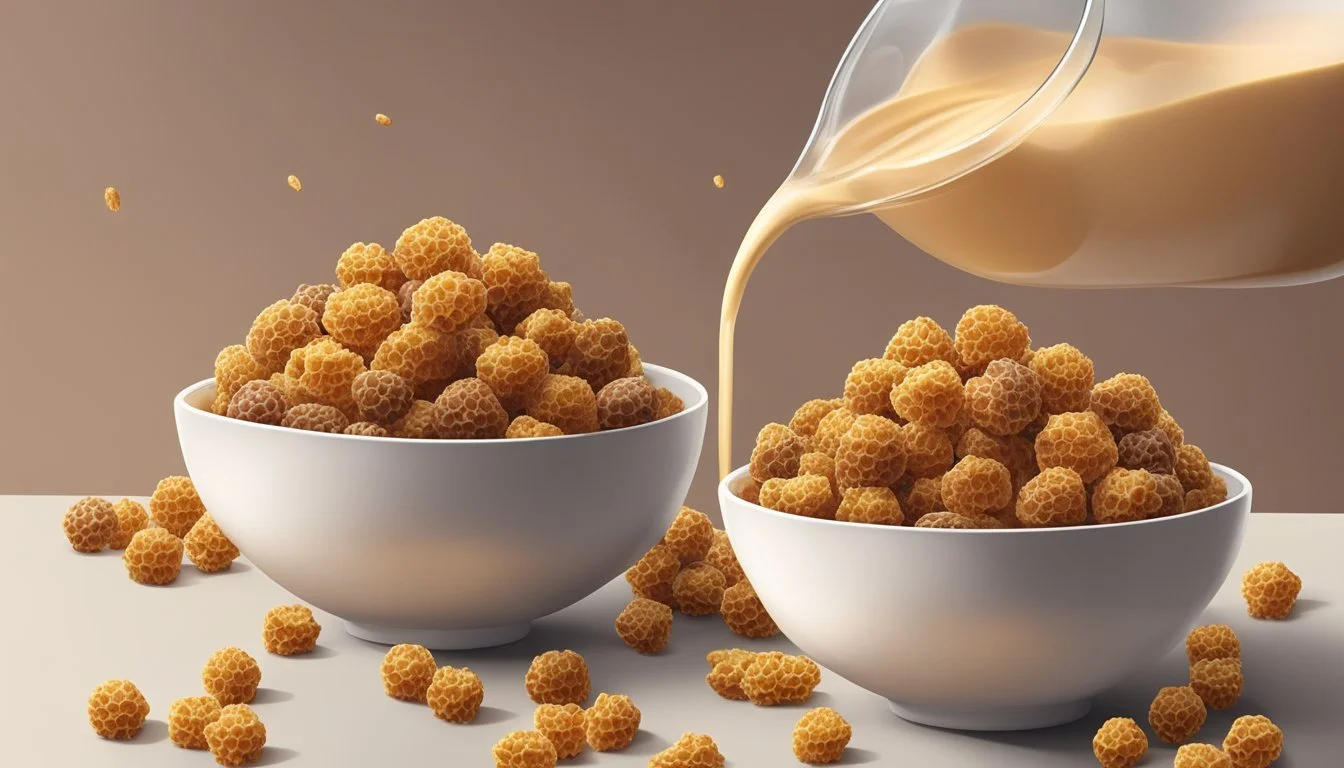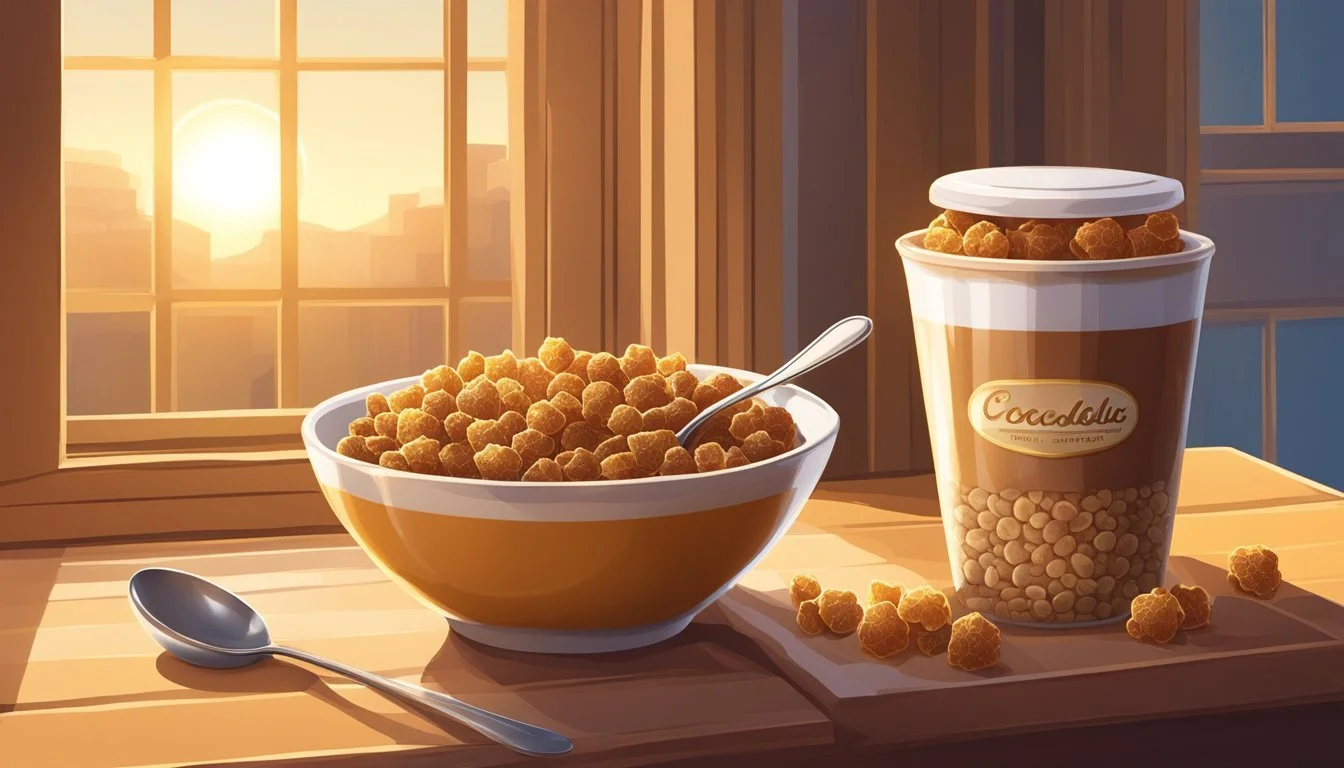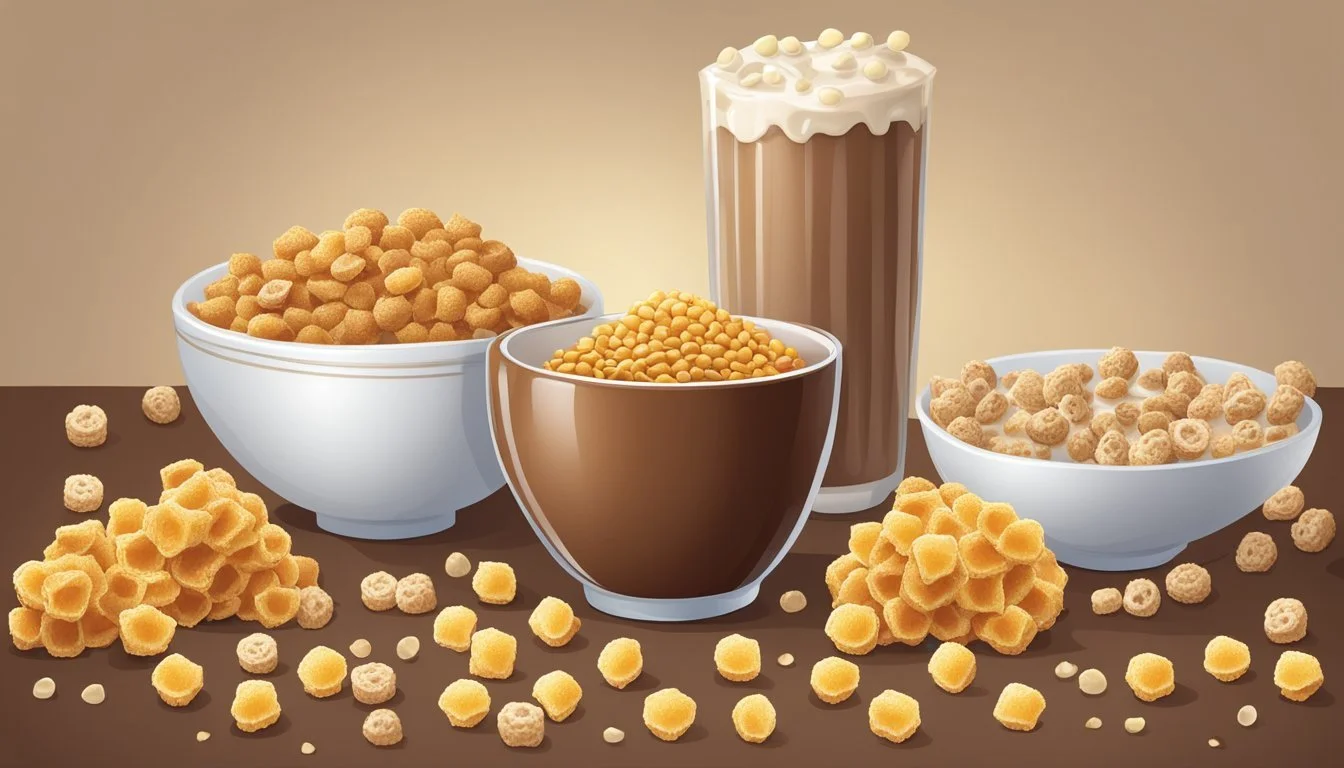Cocoa Puffs vs Honeycomb
Comparing Nutritional Value and Taste
This Article is Part of Our Breakfast Cereal Guide with Details on Cocoa Puffs Nutrition and Honeycomb Nutrition
Choosing the right breakfast cereal can be challenging, especially when faced with popular options like Cocoa Puffs and Honeycomb. Both cereals offer unique flavors and nutritional profiles that appeal to different tastes and dietary goals. Cocoa Puffs, made by General Mills, boasts higher levels of Iron, Zinc, Vitamins B12, B6, B2, B1, and B3 than Honeycomb.
Nutritionally, each cereal has its strengths. Honeycomb, produced by Post, contains more complex carbohydrates and Vitamin D, making it a potentially better choice for sustained energy throughout the morning. Cocoa Puffs, on the other hand, provide a significant amount of key vitamins and minerals that can contribute to daily nutritional needs. This differentiation might influence individuals based on their specific dietary requirements.
Flavor preferences also play a crucial role. Cocoa Puffs delivers a rich, chocolatey experience, while Honeycomb offers a lighter, honey-flavored crunch. For those prioritizing a vitamin boost in the morning, Cocoa Puffs may be the way to go. If the goal is to maintain steady energy levels with a touch of sweetness, Honeycomb could be the better option. Readers must weigh these factors to decide which cereal fits best into their morning routine.
History and Brand Overview
Cocoa Puffs and Honeycomb are iconic cereals with rich histories that have cemented their places in breakfast culture. Cocoa Puffs, created by General Mills, is known for its chocolatey flavor, while Honeycomb, developed by Post, offers a sweet, honey-like taste.
Origin of Cocoa Puffs
Cocoa Puffs was introduced by General Mills in 1956. This chocolate-flavored cereal quickly became a household favorite, especially for children. The cereal consists of small, crunchy orbs made from corn and rice, all infused with a rich cocoa taste.
The brand gained significant popularity through its clever marketing, including the memorable mascot Sonny the Cuckoo Bird, who famously says he's "Cuckoo for Cocoa Puffs."
Development of Honeycomb
Honeycomb cereal was created by Post in 1965. This cereal features large, honey-flavored corn puffs that provide a distinct crunch and sweetness. Initially marketed with a focus on both taste and texture, Honeycomb became a staple in American households.
Over the years, the cereal has undergone various marketing changes but has remained consistent in delivering its unique honey-like flavor.
Both Cocoa Puffs and Honeycomb have stood the test of time, continuing to be enjoyed by generations of breakfast lovers.
Nutritional Comparison
Cocoa Puffs and Honeycomb cereal have distinct nutritional profiles that can influence dietary choices depending on individual health goals. The following subsections will break down their calorie content, sugar levels, protein, fiber, vitamins, minerals, fat, and saturated fat, to provide a comprehensive comparison.
Calorie Content
When considering calorie content per serving, Cocoa Puffs contains about 110 calories, making it a relatively low-calorie option for a chocolate-flavored cereal. Honeycomb cereal, on the other hand, has a slightly higher calorie count, typically around 120 calories per serving.
While the difference may seem minor, it can add up over time for those watching their caloric intake. Choosing between them based on calories alone may depend on daily caloric goals and other nutritional factors.
Sugar Levels and Types
Cocoa Puffs is known for its chocolate flavor, which comes with a significant amount of sugar. Each serving contains approximately 12 grams of sugar. The sugar content is largely derived from added sugars, which can impact health if consumed in excess.
Honeycomb cereal, with its honey flavor, holds about 10 grams of sugar per serving. Although it contains added sugars as well, the slightly lower quantity may be preferable for those managing sugar intake. Both cereals contribute significantly to daily sugar consumption, a consideration for those prioritizing reduced sugar diets.
Protein Content
In terms of protein content, both Cocoa Puffs and Honeycomb cereal provide modest amounts. Cocoa Puffs offers around 1 gram of protein per serving. This is a typical amount for many sugary cereals, which are not primary sources of protein.
Honeycomb cereal provides a slightly higher amount, delivering about 2 grams of protein per serving. While neither cereal is adequate as a primary protein source, Honeycomb's small edge may be more beneficial when supplementing daily protein needs.
Fiber and Whole Grains
Fiber is a crucial nutrient for digestive health and satiety. Cocoa Puffs contains a minimal amount of fiber, with less than a gram per serving, reflecting its composition primarily of refined grains and sugars.
Honeycomb cereal also falls short on fiber, delivering less than 1 gram per serving. Neither cereal includes significant whole grains, which are more beneficial for health. Consumers seeking to increase fiber intake may need to explore whole grain cereals or additional sources of dietary fiber.
Vitamins and Minerals
Cocoa Puffs is fortified with various vitamins and minerals, making it richer in nutrients like iron, zinc, vitamin B12, calcium, vitamin C, vitamin B6, and vitamin B1. It covers daily iron needs significantly, by about 103% more compared to Honeycomb.
Honeycomb cereal, though less dense in these vitamins and minerals, outperforms Cocoa Puffs in providing vitamin D. Fortified cereals like these play a role in supporting daily nutrient requirements but should be consumed as part of a balanced diet.
Fat and Saturated Fat
Cocoa Puffs has a low fat content with less than 1 gram of total fat per serving and virtually no saturated fat. This makes it a favorable option for those monitoring fat intake, particularly saturated fats, which are linked to heart health issues.
Honeycomb cereal is also low in fat, with less than 1 gram per serving, and mirrors Cocoa Puffs in having negligible saturated fat. Both cereals offer a low-fat choice for breakfast, but other factors such as fiber and sugar levels should be considered when making dietary decisions.
Flavor Profiles
Cocoa Puffs and Honeycomb each offer unique taste experiences that appeal to different preferences. These cereals' distinct flavors are shaped by their main ingredients and the balance of sweetness, texture, and other taste factors.
Cocoa Puffs Taste Experience
Cocoa Puffs provide a rich, chocolatey flavor that stands out among breakfast cereals. The intense chocolate taste is combined with a notable sweetness.
Ingredients:
Corn
Sugar
Cocoa Processed with Alkali
The chocolate coating gives Cocoa Puffs a sweet outer layer, which dissolves quickly in milk. This results in a creamy chocolate milk, enhancing the overall experience. As the cereal absorbs the milk, the texture changes from crunchy to slightly softer, creating a dynamic eating experience.
The cereal also contains hints of vanilla and malt, adding depth to the chocolate flavor.
Honeycomb Flavor Characteristics
Honeycomb cereal is known for its milder, honey-sweet flavor. The taste is subtly enhanced by the blend of corn and oat ingredients.
Ingredients:
Corn flour
Oat flour
Sugar
Honey
The primary flavor note is honey, which provides a gentle sweetness without being overpowering. The cereal maintains its crunchiness in milk, offering a satisfying texture that complements its flavor.
Honeycomb's airy, hexagonal shape ensures that each bite has a light and crisp consistency. Additionally, slight undertones of vanilla may be present, contributing to the overall flavor profile. The harmony of corn, oats, and honey offers a balanced taste that pairs well with both milk and yogurt.
Textural Contrast
When comparing Cocoa Puffs and Honeycomb, their textural differences are notable and can greatly influence the overall eating experience. Factors like crispiness, crunch, and the effect of milk on each cereal play major roles in consumer preference.
Crispiness and Crunch Factor
Cocoa Puffs are known for their small, spherical shapes that offer a consistent crispy texture. This crispiness is appreciated by those who enjoy a pronounced crunch in each bite. On the other hand, Honeycomb presents a different textural experience. Its larger, hexagonal pieces provide a lighter and airier crunch due to their unique structure. This creates a more varied textural experience compared to the uniform density of Cocoa Puffs.
Cocoa Puffs:
Small, uniform pieces
Consistent crispiness
Honeycomb:
Larger, hexagonal pieces
Light and airy crunch
Effects of Milk on Texture
When milk is added, Cocoa Puffs tend to retain their crispiness for a longer duration, though they eventually soften. The milk primarily enhances the chocolate flavor while maintaining the cereal's crunch initially.
Honeycomb, being more porous, absorbs milk more quickly. This leads to a softer texture faster than Cocoa Puffs. Some consumers prefer this quicker transition to a milder crunch, while others might find it less satisfying if they favor extended crispiness.
Cocoa Puffs in milk:
Retains crunch longer
Gradual transition to a softer texture
Honeycomb in milk:
Quick absorption
Rapid change to a softer texture
Health and Lifestyle Considerations
When comparing Cocoa Puffs and Honeycomb cereals, several health and lifestyle factors come into play. This includes evaluating their nutritional content, such as carbohydrate types, vitamin and mineral content, and potential benefits or drawbacks related to digestion and overall wellness.
Healthy Breakfast Debate
Cocoa Puffs provide a richer supply of essential minerals and vitamins including iron, zinc, calcium, and several B vitamins, making it a nutrient-packed choice. They are made from whole-grain corn, which contributes to a beneficial fiber content that supports digestive health.
Honeycomb may be higher in Vitamin D compared to Cocoa Puffs, which can be particularly beneficial for bone health and immune function. However, Honeycomb contains more complex carbohydrates per serving, potentially making it a more energy-sustaining option.
Both cereals contain sugar, but the type and amount can affect overall health. Cocoa Puffs tend to have a higher sugar content, which may be a consideration for those monitoring their sugar intake. Neither cereal is particularly high in protein or fat, which might necessitate additional sources of these nutrients at breakfast.
Market Position and Pricing
Cocoa Puffs and Honeycomb occupy distinct niches in the breakfast cereal market. Factors such as consumer perception, pricing strategies, and the value they offer are crucial when comparing these two products.
Consumer Perception
Cocoa Puffs, produced by General Mills, is often seen as a nostalgic and indulgent choice, particularly appealing to those who crave a chocolatey flavor. The cereal's branding leverages its mascot and memorable advertising slogans, which resonate well with both children and adults who grew up with it.
Honeycomb, from Post, is marketed as a fun and adventurous option, with its large honey-flavored pieces and cartoonish branding. It aims to attract consumers looking for a unique texture and taste. Both brands use targeted marketing strategies to reinforce their personas, contributing significantly to how they are perceived in the market.
Affordability and Value
When it comes to pricing, Cocoa Puffs and Honeycomb adopt competitive strategies to maintain their market share. Generally, both cereals are priced within the same range, making them affordable choices for most consumers.
However, promotional offers and discounts can vary, with each brand occasionally providing better value through bulk buying or coupons. For those prioritizing budget, these offers can sway purchasing decisions. Additionally, supermarkets sometimes offer private-label imitations at a lower price point, affecting the perceived value of brand-name cereals like Cocoa Puffs and Honeycomb.
Being mindful of these pricing dynamics can help consumers make informed choices based on both their taste preferences and budget constraints.
Packaging and Branding
Both Cocoa Puffs and Honeycomb Cereal have distinctive packaging and branding strategies. These aspects play a crucial role in attracting consumers and maintaining brand loyalty.
Visual Appeal
Cocoa Puffs by General Mills is known for its colorful and dynamic packaging. The box prominently features the playful mascot, Sonny the Cuckoo Bird, which appeals to children. Bright colors, coupled with engaging graphics, make it visually striking on the shelves. The logo, font, and color scheme all contribute to creating an energetic brand image.
Honeycomb Cereal, on the other hand, opts for a more structured design. The packaging showcases the hexagonal shape of the cereal bits, emphasizing the honeycomb theme. The brand's choice of warm, honey-themed colors and straightforward layout enhances its visual appeal. This intuitive design underscores the product's unique shape and flavor, making it easily recognizable.
Environmental Considerations
Increasing awareness around sustainability has pushed both brands to consider environmental impacts. General Mills has made efforts to improve the sustainability of Cocoa Puffs' packaging. Utilizing recyclable materials and reducing plastic use are steps they have taken towards eco-friendly practices.
Honeycomb Cereal also benefits from Post's focus on sustainability. The packaging often features recyclable cardboard and biodegradable inks. These changes reflect the brand's commitment to reducing its environmental footprint. Both brands highlight these efforts on the packaging, appealing to environmentally conscious consumers while maintaining product integrity.
Consumer Loyalty and Engagement
Consumer loyalty and engagement are critical for the success of any cereal brand. Effective brand mascots and strategic campaigns, along with responsive customer reviews and feedback mechanisms, play significant roles in maintaining and growing a brand's customer base.
Brand Mascots and Campaigns
Cocoa Puffs: Cocoa Puffs, produced by General Mills, has a widely recognized mascot named Sonny the Cuckoo Bird. Sonny's energetic catchphrase, "I'm cuckoo for Cocoa Puffs!" has made the brand memorable to generations of consumers. The character's zany antics in commercials aim to garner strong emotional connections with kids and nostalgic adults alike.
Honeycomb: Created by Post, Honeycomb cereal features different mascots over the years, including a character known as Crazy Craving. While less iconic than Sonny, these mascots have focused on the unique hexagonal shape and honey-sweet flavor of the cereal. Campaigns often emphasize adventure and fun to appeal to a young audience.
Both brands invest in engaging advertising campaigns and occasionally introduce limited-time product variations and collectables. Tony the Tiger from Kellogg's might not represent these brands directly, yet serves as an example of how powerful a consistent mascot can be in driving brand loyalty.
Customer Reviews and Feedback
Customer reviews and feedback are vital in shaping and maintaining brand loyalty for cereals like Cocoa Puffs and Honeycomb. General Mills carefully monitors feedback through various channels such as social media, consumer hotline, and online reviews. This ensures that they can quickly address complaints or suggestions, maintaining trust and satisfaction.
Post employs similar tactics, creating forums and direct feedback options on their website. They emphasize transparency and partnership with consumers, showcasing how they work to improve Honeycomb's recipe or packaging based on consumer inputs.
Both brands promote loyalty programs that reward consumers for repeat purchases and participation in feedback initiatives. Customer loyalty for Cocoa Puffs and Honeycomb not only hinges on nostalgic advertising but equally on attentive and responsive customer service that values consumer input.
Comparative Analysis with Other Cereals
Cocoa Puffs and Honeycomb stand out for distinct reasons in the breakfast aisle. Evaluating them against other popular cereals highlights both their nutritional profiles and unique selling points.
Closest Competitors
When comparing Cocoa Puffs and Honeycomb to other cereals like Frosted Flakes, Lucky Charms, and Cheerios, several differences and similarities emerge. Cocoa Puffs and Reese's Puffs are similar in their chocolate flavors and high sugar content, making them favorites for those with a sweet tooth.
Honeycomb often finds its closest rivals in Corn Pops and Kix, as they all emphasize a crunchy texture with relatively lower sugar levels. Cinnamon Toast Crunch and French Toast Crunch compete with Cocoa Puffs for those looking for sweet, flavorful options at breakfast.
Cereal Main Flavor Sugar Content Unique Nutrients Cocoa Puffs Chocolate High Vitamin B12, Iron Honeycomb Honey Moderate Vitamin D Frosted Flakes Frosted Corn High None significant Lucky Charms Marshmallow High Vitamin C Cheerios Whole Grain Oats Low Fiber, Vitamin B9
Unique Selling Propositions
Cocoa Puffs stands out for its rich chocolate flavor, something mirrored mostly by Reese's Puffs among the competitive set. Its high content of Iron and Vitamin B12 makes it particularly appealing for those looking to boost their daily intake of these nutrients, although its sugar content is a consideration for health-conscious consumers.
Honeycomb distinguishes itself with a generous amount of Vitamin D, double that found in Cocoa Puffs. This makes it a suitable choice for individuals needing to augment their Vitamin D levels. Its honey-flavored crunch also provides a distinctive taste experience that sets it apart from cereals like Golden Grahams or Cap’n Crunch.
Both cereals cater to different preferences and nutritional needs, showing the diversity within the breakfast cereal market.
Conclusion
Between Cocoa Puffs and Honeycomb, both cereals offer distinct nutritional benefits and considerations.
Nutritional Content:
Cocoa Puffs: Higher in Iron, Zinc, Vitamin B12, Calcium, Vitamin C, Vitamin B6, Vitamin B2, Vitamin B1, and Vitamin B3.
Honeycomb: Higher in Vitamin D.
Complex Carbohydrates:
Cocoa Puffs: 12 grams per serving.
Honeycomb: 14 grams per serving.
Cocoa Puffs provides a more significant daily need coverage for Iron at 103% more than Honeycomb. On the other hand, Honeycomb edges out in Vitamin D content.
Each cereal has its strong points, making the choice dependent on specific nutritional needs and preferences.
Please note personal dietary requirements and consult nutrition labels for detailed information.











